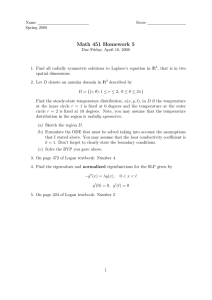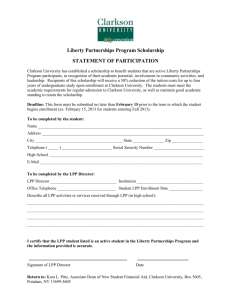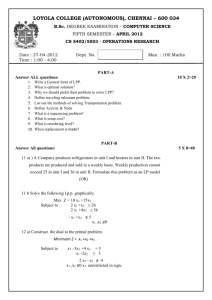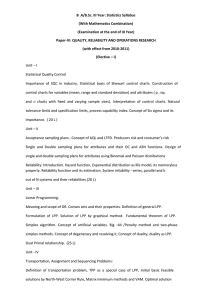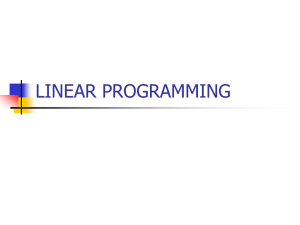Imagineering Inauthentic Legitimate Peripheral Participation: An Instructional Design Approach for
advertisement
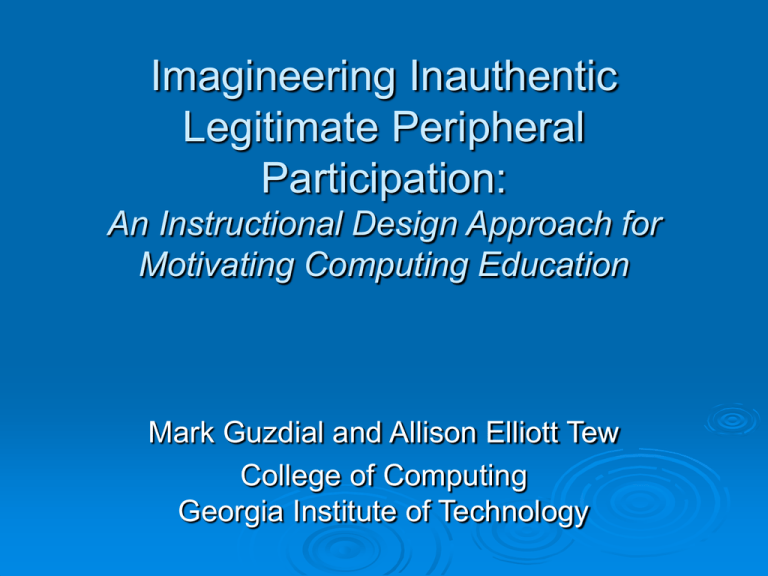
Imagineering Inauthentic Legitimate Peripheral Participation: An Instructional Design Approach for Motivating Computing Education Mark Guzdial and Allison Elliott Tew College of Computing Georgia Institute of Technology Story Legitimate peripheral participation as a theory of learning in a social context. Viewing instruction from an LPP lens. Viewing formal CS education (instruction) from an LPP lens. Alignment and Authenticity Challenge: How do we teach without an existing Community of Practice? Meeting the Challenge: Imagineering Storytelling in three dimensions over time. Using Media Computation as an example Legitimate Peripheral Participation (LPP) Theory of learning from a social perspective Compare to Piaget’s assimilation and accommodation Seeks to explain why students learn and how they do it in informal settings. Addresses issues of motivation and social context that are missing in most cognitive accounts. LPP: About Joining a Community of Practice Learning is becoming a more central/connected part of a community of practice (CoP). CoP have practices and values, forms of communication, and ways of involving newcomers. Students want to be part of CoP, so they engage in LPP. Learning process is legitimate peripheral participation. Newcomers participate at the periphery, but doing useful things. They observe, try, and get corrected. Over time, they take on more roles and become more central to CoP => learning Examples of LPP Positive examples: East African Tailors Midwives Alcoholics Anonymous Negative examples: Modern butcher apprenticeship Formal Schooling? Instruction? Lave and Wenger do not apply LPP to formal schooling, but others do. Instruction that leads a student to a perceived valuable CoP is aligned (Joseph & Nacu) Authentic instruction is aligned. Activities, topics, assessment, methods of inquiry (Shaffer and Resnick) Assumption: LPP and Authenticity Our jumping off point: LPP is an accepted, general theory of learning. • Coming from a social, motivation-oriented perspective. Formal education (instruction) that has a hope of inculcating learning must be authentic. • Students must perceive that the education leads to a valued CoP. Considering CS education from the LPP perspective When the Community of Practice is “professional software developers,” there is no problem. There is a real CoP to study, and we can teach in ways that are authentic for that CoP. In fact, that’s mostly what we do. When the Community of Practice is not professional software developers, there is a problem. What community do students perceive? Where are the programmers or CS-literate communities who are not professional software developers? Teaching computer science without a Community of Practice is inherently inauthentic. Solution: We have to tell a story Our problem: Convey a sense of a CoP. Explain how the instruction is authentic. Solution: Storytelling. But it’s storytelling that isn’t just in printed word or film, not just in one place. It’s story-telling in 3-D over 10-15 weeks. Disney’s Imagineering Theme park design to provide insight into course design: 1. Start from the Story 2. Start from where the expectations are 3. Pay attention to Details 4. Where necessary, change reality 5. Pay attention to Transitions 6. Make the Cast part of the Story Providing Examples from Media Computation Two course sequence at Georgia Tech. Students learn traditional computer science topics, but in the context of media. In CS1315, learn iteration, conditionals, and string processing by manipulating images, sounds, and HTML. In CS1316, learn linked lists, trees, stacks, and queues by learning to implement simulations that drive animations. Results: Higher retention, transfer into computing, success in later CS classes One piece of evidence on success of the class (CS1315) A year after the course: “How has the course changed how you work with computers?” “Definitely makes me think of what is going on behind the scenes of such programs like Photoshop and Illustrator.” 'I understand technological concepts more easily now; I am more willing and able to experience new things with computers now’ 'I have learned more about the big picture behind computer science and programming. This has helped me to figure out how to use programs that I've never used before, troubleshoot problems on my own computer, use programs that I was already familiar with in a more sophisticated way, and given me more confidence to try to problem solve, explore, and fix my computer.’ 1. Start from the Story Everything at Disney theme parks starts with a story. Even changes to vendor booths start from a story. Examples: Tomorrowland Big Thunder Railroad Splash Mountain Emporium 1. Start from the Story In In CS1315, we tell a consistent story All media are going digital Digital media are manipulated in software Knowing how to program is an advantage in a profession that manipulates media. CS1316, it’s all about the wildebeests and the villagers 2. Start from where the expectations are “Just as Main Street, U.S.A. in the Magic Kingdom and Hollywood Boulevard at Disney-MGM Studios are not meant to represent factual history, but to evoke a collective cultural memory, the flavor of the 1920’s midAtlantic coast is apparent at Disney’s BoardWalk” --Kurti, Since the World Began 2. Start from where the expectations are Partially, this is about peripheral participation These students have been peripherally participating in media manipulation culture All collect media Many use Photoshop Some work with MIDI and sound (“Acid”) We start with the media and manipulations they know. 3. Pay Attention to Details All the elements play off one another and feed into a consistent view. 3. Pay Attention to Details The lectures match the book which matches the assignments (which are about media manipulation) which match the on-line Galleries. The examples in the book used the same media as on the CD at the back of the book. The story is told consistently and are selfsupporting pieces of evidence. “Of course people manipulate media with Python! Go look at all the great things in the on-line Galleries!” 4. Where necessary, change reality Three story buildings in Disney World aren’t really three stories. Another Example: Cinderella’s Castle -The View -The Tunnel 4. Where necessary, change reality Python does not support media manipulation. So we wrote a set of libraries and tools. We embedded them into the programming environment so that students never even see the media libraries being imported. Now, obviously, Python supports media manipulation. Java’s media support is complicated. We never teach it. We teach Picture, Sound, Pixel, and SoundSamples. 5. Pay Attention to Transitions Imagineers care about what you see between places. Why are there water buffalo on top of the Tiki-Tiki room? Why are the Thunder Mountain mountains scarier in Florida than California? 5. Pay Attention to Transitions At each new topic, we relate the transition to the story. We don’t start teaching string processing, we start teaching HTML. We don’t teach linked lists, we teach how to dynamically and creatively insert and remove media elements. 6. Make the Cast Part of the Story 6. Make the Cast part of the Story Students become part of the story in lecture: “This is a great collage on the Gallery this week. Who did it? You? How’d you do it? How’d you get this great effect?” TA’s get sucked in. Some of the best media on the Gallery pages are by the TA’s (“as examples”) Conclusion: The Story May Not be the Impact There’s evidence that students in CS1315 don’t buy the story. Suggestive evidence #1: Re-read those followup survey comments. They don’t buy that learning to hack media is useful for their career/profession. But instead, they think it’s part of being a media consumer. That’s not about work. That’s about life. Suggestive evidence #2: Students tell us that the homework is not relevant. But is useful for daily life
